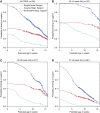Comparisons and Limitations of Current Definitions of Bronchopulmonary Dysplasia for the Prematurity and Respiratory Outcomes Program
- PMID: 26397992
- PMCID: PMC4722827
- DOI: 10.1513/AnnalsATS.201504-218OC
Comparisons and Limitations of Current Definitions of Bronchopulmonary Dysplasia for the Prematurity and Respiratory Outcomes Program
Abstract
Rationale: Bronchopulmonary dysplasia is the most common morbidity of prematurity, but the validity and utility of commonly used definitions have been questioned.
Objectives: To compare three commonly used definitions of bronchopulmonary dysplasia in a contemporary prospective, multicenter observational cohort of extremely preterm infants.
Methods: At 36 weeks postmenstrual age, the following definitions of bronchopulmonary dysplasia were applied to surviving infants with and without imputation: need for supplemental oxygen (Shennan definition), National Institutes of Health Workshop definition, and "physiologic" definition after a room-air challenge.
Measurements and main results: Of 765 survivors assessed at 36 weeks, bronchopulmonary dysplasia was diagnosed in 40.8, 58.6, and 32.0% of infants, respectively, with the Shennan, workshop and physiologic definitions. The number of unclassified infants was lowest with the workshop definition (2.1%) and highest with the physiologic definition (16.1%). After assigning infants discharged home in room air before 36 weeks as no bronchopulmonary dysplasia, the modified Shennan definition compared favorably to the workshop definition, with 2.9% unclassified infants. Newer management strategies with nasal cannula flows up to 4 L/min or more and 0.21 FiO2 at 36 weeks obscured classification of bronchopulmonary dysplasia status in 12.4% of infants.
Conclusions: Existing definitions of bronchopulmonary dysplasia differ with respect to ease of data collection and number of unclassifiable cases. Contemporary changes in management of infants, such as use of high-flow nasal cannula, limit application of existing definitions and may result in misclassification. A contemporary definition of bronchopulmonary dysplasia that correlates with respiratory morbidity in childhood is needed. Clinical trial registered with www.clinicaltrials.gov (NCT01435187).
Keywords: bronchopulmonary dysplasia; infant; neonatal lung disease; oxygen inhalation therapy; premature.
Figures


References
-
- Stoll BJ, Hansen NI, Bell EF, Shankaran S, Laptook AR, Walsh MC, Hale EC, Newman NS, Schibler K, Carlo WA, et al. Eunice Kennedy Shriver National Institute of Child Health and Human Development Neonatal Research Network. Neonatal outcomes of extremely preterm infants from the NICHD Neonatal Research Network. Pediatrics. 2010;126:443–456. - PMC - PubMed
-
- Shah PS, Sankaran K, Aziz K, Allen AC, Seshia M, Ohlsson A, Lee SK Canadian Neonatal Network. Outcomes of preterm infants <29 weeks gestation over 10-year period in Canada: a cause for concern? J Perinatol. 2012;32:132–138. - PubMed
-
- Stroustrup A, Trasande L. Epidemiological characteristics and resource use in neonates with bronchopulmonary dysplasia: 1993-2006. Pediatrics. 2010;126:291–297. - PubMed

